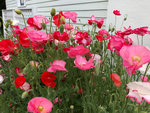

Once I was sent to the hardware store to buy nails. I knew nothing about construction. When the clerk said “box or common?” I just felt ignorant and incompetent – which, of course, I was. So I have a lot of sympathy for people who look puzzled as they survey a seed rack. I imagine them wondering what the difference is between annuals and perennials.
So here it is: perennials live for many years. Annuals live for only one.
But that’s really not the whole story. Many annuals will reseed themselves and grow new plants the next year and for many years to come. And those are our topic today.
Love-in-a-Mist
For instance, possibly the easiest flower on earth to grow is called Love-in-a-Mist. Doesn’t the name alone make you want to plant it?
I planted Love-in-a-Mist seeds once, many years ago. Now each spring I pull 90 percent of the seedlings it sends up and still have an abundance of it. It’s an ethereal little beauty, a foot or two tall, mostly blue, sometimes white. Its ferny foliage can grow through or around other, more substantial plants. It’s a nice cut flower, and after it has flowered, it’s a good candidate for dried arrangements. Little kids like to open the dried seed pods and scatter the seeds.
This is a flower best suited to an informal style of gardening, as it is not a rule-follower and will come up where it pleases.
I should qualify the statement that it’s the easiest of all flowers to grow; there is competition for that title from nasturtiums and also from another of my favorites, alyssum.
Alyssum
Alyssum is a low-growing, front of the flower bed edging plant that can go from seed to flower in six weeks. It also reseeds itself, though not nearly so aggressively as Love-in-a-Mist. White alyssum has a heavenly fragrance, especially in the evening, and so do the pink and purple versions, though theirs is lighter.
Several other good choices
Also, as you’re standing in front of the seed rack, look for clarkia, larkspur, godetia, and bachelor’s buttons/cornflowers. All of these germinate readily – if, of course, you remember to keep them damp until they come up – and will flower by August. Most will reseed themselves, so it’s a good idea to pay attention to what the seedlings look like so you’ll recognize them when they return next spring. And as a bonus, when they do return next year, you can dig them up and move them around pretty easily. And none will reseed themselves as prolifically as Love-in-a-Mist.
Shirley Poppy
Then there is the glory of the garden: Shirley poppies. They are a bit touchy about germination. I noticed on a seed package that the directions are to cover the super tiny seeds with 1/16th of an inch of soil. Ha! You’d have to call a cabinet-maker to achieve such a precise measurement. So it may take more than one try to get the seeds to come up, but the reward will be worth far more than the effort. And once established, Shirley poppies will be with you for many years.
Initially, they will flower in a wide range of delicate pink, white, red and orange, with bicolor combinations that dazzle even the most garden-oblivious gearheads. Mysteriously however, over several years red becomes predominant, and the more delicate colors disappear. For this reason, I replant from seed once every five years or so.
I am sure there are many other worthy flowers on those seed racks, but these are the ones whose character I can vouch for, and whose blooming season I eagerly await.
Jill Severn writes from her home in Olympia, where she grows vegetables, flowers and a small flock of chickens. She loves conversation among gardeners. Start one by emailing her at jill@theJOLTnews.com
Comments
No comments on this item Please log in to comment by clicking here